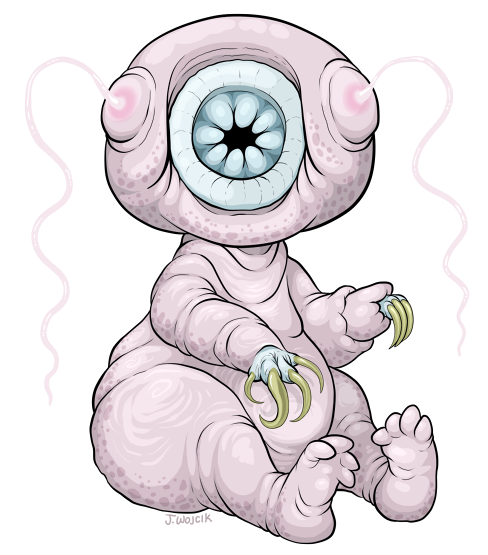
CLASS: ARTHROPOID BIOLOGY: The Mosslet is a tiny, slow-moving monster, interested primarily in grazing upon moss, lichens, algae, fungi and the occasional bit of meat, depending upon the sample species. Some specimens may be more predatory than others, and some may even derive from fluid-feeding, parasitic Tardigrada. In any case, their metabolic processes are sluggish enough that they seldom actually require a meal, and spend most of their existence wavering in and out of sleep. Mosslets are comfortable in air or water, though they prefer water. BEHAVIOR: Mosslets seem to feel little else but apathy, only dimly aware of danger and sluggish to respond. APPLIANCE: With its macroscopic, parahuman physiology, a Mosslet cannot quite enter the absolute dessicated hibernation of its arthropod basis, but achieves an effective enough approximation suited to a larger scale. In seconds, the creature can collapse its hollow, rubbery body into a dense, tightened "knot" and slow its biological functions to a crawl for up to a few weeks. In this condensed state, the Mosslet is virtually impervious to extremes of temperature, pressure, acidity or electricity, and its cognitive functions simplify to a level even a Cognosticator cannot penetrate. While a Mosslet's natural offensive capabilities are extremely minimal, its small size, ability to hide itself and its incredible defenses can support a variety of combative strategies. Mosslet have been known to train as long-range gunners, explosives experts, psychohackers, parasite carriers, field medics, assassins and more. PSEUDO TUN: a Mosslet can quickly enter a semi-hibernative, hardened state, roughly spherical and less than a third its natural volume. In this state the monster is incredibly difficult to damage by physical, kinetic or chemical means, resistant to mental attack and all but invisible to most biological or technological sensory systems, resembling little more than a lump of detritus. BITE: even an herbivorous Mosslet is armed with a retractable fluid-feeding stylet, strong enough to puncture flesh, bone or chitin.   Contents copyright Jonathan Wojcik
|